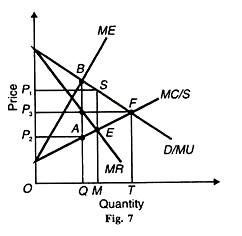

The National Football League, Major League Baseball, and National Basketball Association come very close to being monopsony buyers of athlete labor services.
#Bilateral monopoly examples professional#
Athletic Labor Services: Perhaps the factor markets that come closest to the bilateral monopoly model are those involving the labor services of professional athletes.As the bilateral model suggests, one-on-one negotiation over the price is a common feature of such purchases. These purchases often include a single buyer and a single seller. Consumer Goods: A number of modern consumption purchases, such as buying a house or a car, tend to fit the bilateral monopoly model.While these markets are not, strictly speaking, comprised of pure monopoly sellers and pure monopsony buyers, the do have a definite bilateral monopoly flavor. Negotiations between large corporations and labor unions over wages and working conditions, such as those between General Motors and the United Autoworkers Union, approximate the bilateral monopoly model. Industrial Labor: While the company town might be largely a thing of the past, a number of modern labor markets contain a dominate employer on the buying side and a dominate labor union on the selling side.Modern ExamplesWhile markets dominated by a company-town-type monopsony employer on the buying side and a monopoly labor union on the selling side are rare in the modern economy, the bilateral monopoly model provides insight into other markets. The expressed goal of most unions was to monopolize the selling side of a labor market AND balance the monopsony power of the employer. The workers sought to counter these less than desirable situations, by forming labor unions. The expected monopsony outcome, especially low wages, inevitably resulted. During this period, large industrial activities (factories, mines, lumber operations) commonly created monopsony markets by dominating the labor market of a given community (a so-called company town). industrial revolution, the late 1800s and early 1900s. The bilateral monopoly model was developed to explain assorted labor markets operating in the early days of the U.S. The bilateral monopoly model, with a single buyer and a single seller, can be used to analyze many types of markets, but it is most relevant for factor markets, especially those for labor services. Where the price ends ups depends on the relative negotiating power of each side. Then resulting price could be anywhere between the higher monopoly price and the lower monopsony price. When combined into a bilateral monopoly, the buyer and seller both cannot maximize profit simultaneously and are forced to negotiate a price and quantity.

A market dominated by a profit-maximizing monopsony tends to pay a lower price. A market dominated by a profit-maximizing monopoly tends to charge a higher price. Without the division of labor the comfortable standard of living currently provided by our exceeding complex economic system would not be possible.īILATERAL MONOPOLY: A market containing a single buyer and a single seller, or the combination of a monopoly market and a monopsony market. It is, for example, essential to foreign trade. This division-of-labor notion is one of those concepts that is so fundamental to the economy that its importance is occasionally overlooked in the real world. Efficiency achieved through specialization and the division of labor was popularized by Adam Smith in his classic work, The Wealth of Nations. This allows workers to specialize in production as each becomes highly skilled at specific tasks. AmosWEB means Economics with a Touch of Whimsy!ĭIVISION OF LABOR: A basic economic notion that labor resources are used more efficiently if work tasks are divided among different workers.


 0 kommentar(er)
0 kommentar(er)
